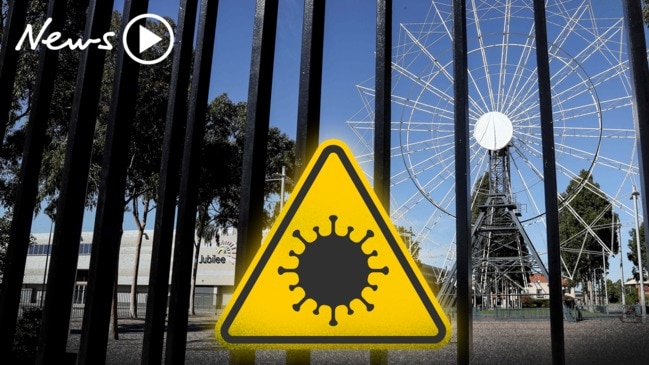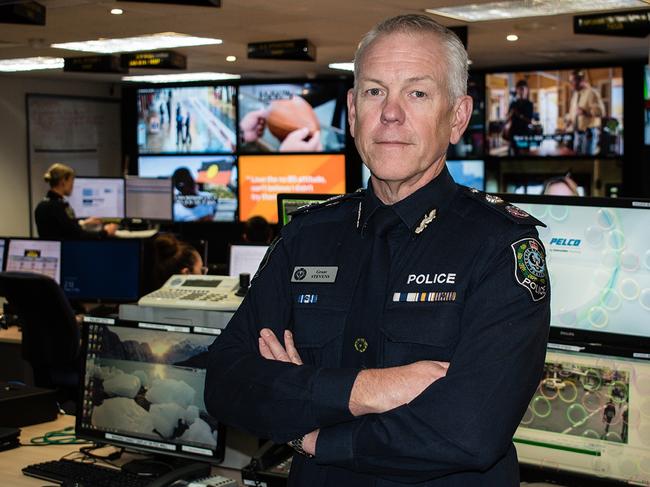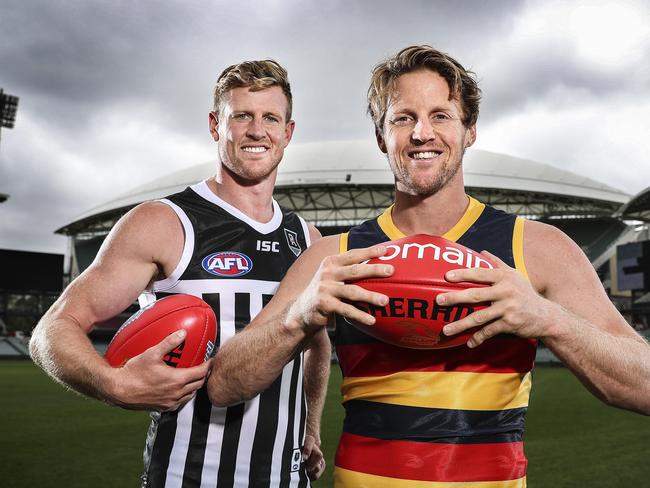SA Weekend inside story: How police work to enforce border checks and quarantine rules helped South Australia dodge a bullet on COVID-19
In Part 1 of our series on SA’s response to COVID-19, Police Commissioner Grant Stevens explains how the state’s emergency services took decisive action to save lives as the virus spread.

SA Weekend
Don't miss out on the headlines from SA Weekend. Followed categories will be added to My News.
- Inside SA’s COVID-19 response, Saturday: Nicola Spurrier
- Inside SA’s COVID-19 response, Sunday: Stephen Wade
- Inside SA’s COVID-19 response, Monday: Steven Marshall
Every Monday and Friday, a group of the state’s most senior public servants meets in a nondescript conference room on the 16th floor of the State Administration Centre.
The Senior Management Council meetings are regular gatherings where government chief executives usually deal with strategic policy issues that seek to ensure South Australians get the best out of their public service.
But the SMC meeting on February 24 was anything but routine.
It took on a different, more heightened tone as the head of SA Health, Dr Chris McGowan, briefed those seated around the table on an issue that was rapidly emerging – and would soon become all-encompassing.
Each individual in the room had already been watching international and national developments with coronavirus, but they were probably not prepared for McGowan’s sobering forecast.
For the next 30 minutes he and chief public health officer Nicola Spurrier briefed the executives – including Police Commissioner Grant Stevens, Premier and Cabinet chief executive Jim McDowell (who chairs the meetings), and the heads of other government departments, including Public Sector Employment, DPTI, Education, PIRSA, Trade and Investment and Treasury – on the tidal wave that was heading South Australia’s way.

The trip from the state administration building to police headquarters took Stevens, 56, less than 10 minutes that day. But that gave him time to think clearly on what his first vital steps would be to prepare SA’s police for the coming storm.
Strategic meetings of the senior executive leadership team occur regularly at SA Police. Coronavirus became one such discussion point almost immediately after the SMC meeting, and tasks were allocated to individuals based on the information that had been received.
One of the first tasks was allocated to SA Police’s business continuity executive management group, which comprises several key members of the executive leadership team.
The group went through an intensive period of work in which it met daily from late February and into early March, to build the capability and capacity required to ensure the organisation was ready for the impending crisis.
Stevens’ fears were reinforced at a briefing on March 6 at the State Emergency Centre. SA Health’s top brass, including McGowan and Spurrier, spoke.
At that time there were 57 cases and two deaths nationally. There were seven cases in SA – all connected to international travel.
While the work the business continuity group was doing was significant, the first major operational step came when Stevens activated a police operations centre on March 16.
At the same time he appointed another executive as SA Police’s COVID-19 co-ordinator and established a police coronavirus management plan.
Those decisions were made just 48 hours after McGowan declared a public health emergency on March 14.

“We had spoken continually the previous week and on the weekend, and as state co-ordinator I was required to endorse his decision under the Public Health Act,” Stevens says. “That was the first time I have ever been required to support such a decision and I think it was the first time we have ever forecast that we were going to be confronted with such a significant public health-related emergency.”
The decision to activate the police operations centre is not taken lightly. It demands diverting resources and it has been operating every day since it was activated.
On the same day the centre was activated, Stevens convened a full-day meeting revolving around the police’s role in responding to the pandemic.
It involved the SA Police executive and every chief superintendent, along with key civilian executives.
“We went through a whole range of strategic discussions in relation to what it meant for us. That was really when we dedicated a serious proportion of our efforts towards ensuring we were ready to respond,” Stevens says.
The meeting examined how core business would be conducted if predicted police absenteeism rates were accurate and what new pandemic-related tasks could emerge that would have to be managed, along with a plethora of other measures, including cancelling all leave and non-essential training, identifying the impact on cadet training and graduations, exploring work-from-home opportunities for staff, ensuring sufficient PPE for frontline officers, increasing cleaning protocols for vehicles, buildings and equipment, stopping static RBTs, cells management issues, redeployment of staff and reviewing interstate and intrastate travel requirements.

Police commissioners around the nation also established a video-conferencing format, as did deputy commissioners, to enable them to talk to each other twice weekly.
There was little time to ensure those plans were in place. The very next day McGowan started issuing directions under the emergency declaration, the first forcing those returning to SA from overseas into quarantine for 14 days.
“That was the start of the increased responsibilities for us,” Stevens says.
“That process wasn’t just about enforcement; it was ensuring people understood their obligations and provided assistance or support if required.”
In further conversations with McGowan and Premier Steven Marshall, it became apparent drastic action was needed. Stevens spoke with Marshall early on March 22 and advised him he was about to make an emergency declaration, a move that essentially revoked McGowan’s March 14 public health emergency declaration.
“The Premier had questions and we had a fairly frank conversation about what I was considering in terms of the response and the significance of what we were dealing with,” Stevens says. “To his credit, he has never, in my conversations with him, encroached on the operational dimensions. He has been very supportive and incredibly calm and measured.”
During that call the need to impose cross-border travel restrictions was discussed, to ensure the state was further isolated from the growing case numbers in Victoria and NSW.

While the declaration was significant, SA Health was still very much in control of the emergency. Stevens’ role was now to give effect to what SA Health needed to achieve its goal: to protect the community.
“The declaration and my role as state co-ordinator enabled Health the ability to focus on the critical health requirements of the emergency and they got the support they needed,” he says.
The goal was to essentially flatten the curve – using whatever means necessary to stop the spread of the virus. And stopping the spread of the virus was entirely contingent on minimising contact between individuals. The declaration gave Stevens the power to impose restrictions on the community.
The responsibilities of police would increase considerably on March 24 when border restrictions were introduced.
Over the ensuing weeks up to 300 officers would become involved in SAPOL’s response – ensuring not just those in self-quarantine were complying, but policing other restrictions on public and private gatherings of no more than 10 people and ensuring businesses deemed non-essential services – such as hotels, restaurants and cafes – were also complying with their requirements.
More than 180 police officers a day were involved on April 20 and 21 when two planeloads of overseas arrivals were quarantined in city hotels.
While a two-week enforced stay in a hotel may have inconvenienced those subject to it, the ramifications of many restrictions imposed during the pandemic have had far-reaching and long-lasting consequences. That fact is not lost on Stevens.

“The non-essential businesses direction was probably the one I felt was going to have the most significant consequences – it would cause people to shut their businesses and impact people’s livelihoods,” he says.
“The gatherings decision, yes, it impacted the community in many ways. It virtually stopped sporting events, visiting places of worship and dramatically impeded funerals and weddings overnight.
“But the non-essential businesses direction forced people into unemployment and forced businesses to close their doors. I knew it would have the greatest impact.”
Stevens was thinking of his own friends and family who would be directly affected as he signed the order.
“Very close friends of mine found themselves thinking about how they were going to pay their mortgages as a result of that decision,” he says.
“I knew they were going to struggle. One of my adult children was affected by this and the children of some of our friends no longer have secure employment.”
Stevens says he has never doubted the decisions, but he has reflected on them during countless nights when he has been unable to sleep properly.

And while he knows the community is now questioning their longevity, he believes they were readily accepted initially because South Australians saw how much harsher such measures were interstate.
Stevens admits there were some occasions early in the crisis when directions were made that had unintended consequences for some people.
“People were working on drafting the directions seven days a week, for 16 or 17 hours a day, to get them right, but as much as you try to think of everything, it is impossible to identify every possible consequence,” he says.
“That is why when you look at the directions there are amendments, it is because when we identified an unintended consequence we have acted to clarify what people can or can’t do, or to address a consequence that was not foreseen.”
Just as Stevens had predicted from the onset of the restrictions, winding them back would prove more difficult. While some were simple decisions, others not so. From early May, as SA started recording consecutive days of no new cases, pressure started mounting to lift restrictions.
One such difficult decision involved saying no to the fly-in, fly-out proposal for SA’s AFL teams. As a football fan who misses the game as much as any other, Stevens says the proposal was too risky.
“It was a decision dealt with by the transition committee to not endorse the model because it created a risk to the community of SA,” he says.
“There was no way community safety could be guaranteed with the two SA clubs travelling to and spending time in the eastern states and then returning to SA.”
Stevens readily admits he feels SA dodged a bullet, compared with other jurisdictions. He credits the positive outcomes in SA to teamwork.
“The way different agencies came together to respond to COVID-19 is why we are in the position we are in now,” Stevens says.
“Health, police, emergency services agencies and other public sector agencies did what needed to be done. And the way SA responded has been a key factor in flattening the curve.”
In the initial weeks of managing the crisis, Stevens’ down time was minimal. A keen cyclist, he has managed to de-stress during recent weekend rides as the tempo of managing the response has settled. A few red wines with close family and friends have also been a welcome relief.
“I have been cautious with both,” he says wryly.
“Ironically, it has been safer on the roads because there has been less traffic. And within the constraints, we have tried to keep in contact with close friends.
“But I can’t tell you where the time has gone. I have not felt fatigued – a part of you embraces the challenge, the opportunity to be involved in the response. I feel privileged I have been able to do this.”
This article is Part 1 of a special four-part SA Weekend series taking you inside South Australia’s response to COVID-19.
